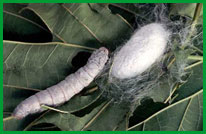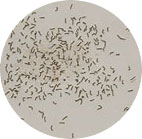|
|

|
About Silkworms
|
General Information, Caring For & Breeding Silkworms
 Background
Background
Silkworms are the larva of a moth (Bombyx mori) native to Asia that spins a cocoon of fine,
strong, lustrous fiber that is the source of commercial silk.
The culture of silkworms is called sericulture. The various species raised
today are distinguished by the quality of the silk they produce.
Silkworms feed on the leaves of the mulberries (genus Morus) and sometimes on the Osage
orange (Maclura pomifera).
Bombyx Mori will not bite, making it an ideal worm for feeding most reptiles,
amphibians and other animals. And they offer great nutritional value as a live feeder.
|

Mulberry Leaves
|
Newborns are small enough for
most baby reptiles to eat and young silkworms can even be fed so they will
grow to a desired size.
Silkworms are soft-bodied, slow moving and can
grow to 3 inches in length. They are also relatively fast growing,
reaching about 3 inches in length and ready to cocoon in as little as 25 - 28 days.

Silkworm and Cocoon
|
Silkworms go through four stages of development, as do most insects:
egg, larva, pupa and adult.
Click here to see a life cycle chart.
The adult (imago) stage is the silkworm moth.
The larva is the caterpillar (not really a "worm" at all). The pupa is what the silkworm
changes into after spinning its cocoon before emerging as a moth.
Since the silkworm grows so much,
it must shed its skin four times while it is growing.
These stages-within-a-stage are called instars.
Today, the silkworm moth lives only in captivity. Silkworms have been
domesticated so that they can no longer survive independently in
nature,
|
particularly since they have lost the ability to fly. All
wild populations are extinct. Also contributing to their extinction
is the extraordinary fact that they only eat mulberry leaves.
Silkworms have been used by researchers to study pheromones or sexual
attractant substances. The pheromones are released by female moths and
the males detect the chemicals with olfactory hairs on their antennae.
This allows the male to find the female for mating. The male antennae
are made of many small hairs to increase the chances of picking up small
amounts of the pheromones over long distances.
 How to Grow Your Worms to the Perfect Size
How to Grow Your Worms to the Perfect Size

Silkworm Eggs and Moth
|
The great thing about silkworms is that they only grow as much as you feed them,
and they can go for up to a week without food. Keep in mind, however,
that they will become dehydrated and begin to die off after a few days without food, and should
be fed at least once daily in order to remain healthy.
But, in general, if you have too many you can
feed them a few times per week and they'll
stay alive until you need them without growing too much larger.
|
Wash hands thoroughly before handling the worms or the food or they
may develop bacterial problems. Using a cheese grater, grate a small amount of
food onto the them and repeat until the caterpillars reach the desired size.
For best results, maintain temperatures between 78° and 88° F.
Excessive condensation forming in the container after feeding
is the leading cause of failure. If this condensation does form, take
the lid off your container and allow the container and old food to completely dry out.
In the future, make sure the previous food is dry before feeding again.
Old damp food is a breeding ground for mold and other problems, dry food is not.
A fan can help for quicker dry outs.
|

Newly hatched silkworms are tiny
|
As the silkworms grow, you may need to transfer your worms to a larger
plastic container.
The lid needs to have ventilation holes. If not, you need to vent the lid
so the silkworms won't suffocate and to allow condensation to dissipate.
You can also use a shoebox. The old food and waste matter can be removed, but does not have to be if it
remains thoroughly dry.
Under ideal conditions (78° to 88° F and allowed to feed nearly continuously)
silkworms can go from egg to 1 inch in length in about 12 days, and 3 inches in under 30 days.
The worms will begin to spin cocoons at about 28 - 30 days old or when they are between
2 1/2 and 3 inches long.
For more detailed silkworm care instruction, please see our
FAQ page.
 From Cocoon to Moth
From Cocoon to Moth

Silkworm Moth
|
Silkworm moths emerge from their cocoons after spending about two to three
weeks metamorphosing. As moths, they do not eat or fly. They will usually mate,
lay eggs and die within a week. Fertile eggs turn from yellow to gray or purple
in a week or so. If the eggs don't hatch within 3 weeks, they usually will not hatch
until the following year (see above—from egg to larva).
|
 Proper Handling Procedures
Proper Handling Procedures
Again, in order for your worms to stay healthy for many weeks, you'll need to keep the
silkworms as dry as possible. If condensation builds up during feeding, vent the
container lid to prevent excess humidity.
Be sure to wash your hands thoroughly before handling the worms
or their food. Silkworms can be susceptible to bacteria if you don't properly handle them.
As long as the container environment remains dry, your worms will be fine.
Mold develops from high temperatures and high humidity.
If the worms are covered with droppings, silk and old food for too long,
mold may develop and kill the worms. If mold does develop, grate about 1/4 inch of
food (sold separately)
all over the worms with a cheese grater. As the worms crawl to the top of the
new food pile you can transfer them off the moldy food and place them into a new container.
Silkworms are susceptible to bruising and dying if not handled with care, especially as
they grow larger.
When handling and transferring the worms, be very gentle.
For more information about caring for this amazing creature, see our
Frequently Asked Questions. You may also want to visit our page about the numerous
benefits that it offers HERE.
If you would like to purchase silkworms, Please visit our SHOP HERE.
Further Reading
Wikipedia.org - As always, this website is a wonderful place to find information on just about anything.
Sue Kayton's Website is a good source for K-12 teachers who want to raise silkworms in their classroom.
The Culture of the Mulberry Silkworm
is a free ebook available on Google. It is from the U.S. Department of Agriculture and provides a wealth of information about caring for and rearing silkworms.
|
Copyright © 2025 DBA: The Silkworm Shop
The information on this page is copyrighted and may not be reproduced or used without permission.
|
|
|